GAMES
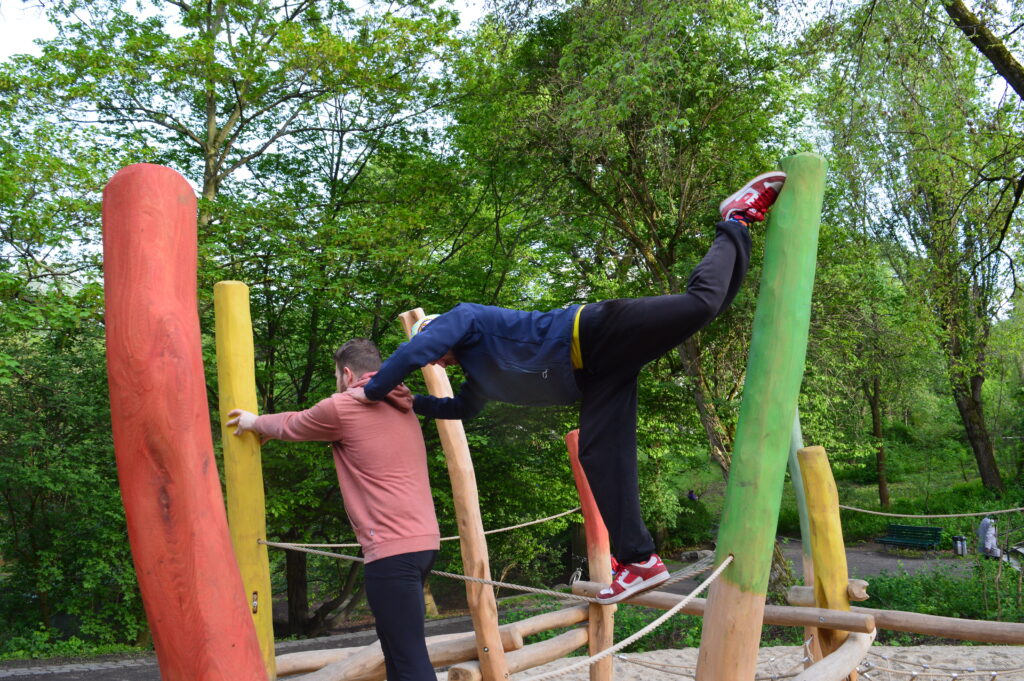
‘STAY A CHILD AND PLAY.’
.
Why don’t you play?
For children, all of life is a game. There are always new things to explore, new possibilities to discover and the world to explore from different positions. Games are an eternal companion in our lives and don’t just have to be played at the table.
We learn a lot through games. Rules, concentration and social and emotional skills.
What is important to me is the fact that games make our training more interesting than just repeating things.
We can have a standardised training session even though we are only ‘playing’. If you are interested, you should look here for some games to include in your training sessions or to teach.
.
EIGHT RUN
The field is a figure eight that is drawn with chalk. You can add obstacles and make the eight as big as you like.
One person stands at each end of the eight. On ‘GO’, each person tries to catch the other.
The person who catches the other person first is the winner.
If you make the field bigger, you can also have three or four people start.
.
SNEAK UP
One person stands with their back to the other person. There are obstacles along the way that need to be overcome.
One person must try to tap the other person without being heard along the way.
If one person hears the other, the person has to start again from the beginning.
.
OTHER SIDE
This game is played using movements you already know. Most parkour practitioners are good at one side but not so good at the other, or even unable to do it at all. Choose a few movements and try to switch sides.
.
BRING OUT OF BALANCE
One person stands on one leg. The other person tries to unbalance them.
The person must not be touched, but only made to sway through movements.
If you want to make it more difficult, stand with one leg on a stone, a pole or something else that is not quite straight.
.
PICK UP BALLS
One person may only move on the obstacles.
The other person places balls on the floor near the obstacles.
Now the person on the obstacles must try to pick up the balls without touching the ground with their hands or feet.
After a few attempts, you can swap roles.
If you want to make it more difficult, you can pick up the balls with your feet.
.
CATCH BALLS
One person is given a ball that can bounce (e.g. a tennis ball). The other person stands with their back to the person with the ball. The person with the ball throws the ball over the other person, who must try to catch the ball after tapping it once.
Variation I: The person catching the ball sits on the floor
Variation II: The person catching the ball lies on the floor
Variation III: The person catching the ball sits or lies on the floor with their eyes closed and has to wait for the throwing person to give the signal.
.
FOLLOW BALLS
Each person gets a ball.
Each person throws the ball and must follow the same path as the ball. If the ball flies over something, you have to climb over it, if it rolls under something, you also have to go through it.
Each person decides the distance and difficulty of his/her route.
The start and end are the same for everyone.
.
OBSTACLERACE
There are several lanes marked out with chalk. A start, a finish and a line in the centre on which the balls lie.
Each person is given a cube and has to get from the start to the finish.
1 = bounce once, 2 = bounce twice, 3 = bounce three times
4 = lie down on the floor once and stand up again
5 = do a stretch jump
6 = turn round and continue playing backwards, play forwards again on the next 6, etc.
If you get to the ball on your lane and roll a 2 or 3, nothing happens. If you roll a 4, 5 or 6, you have to lie down on the floor, do a stretch jump or turn round.
If you roll a 1, you can place the ball on another person’s lane (throwing is not allowed).
The game is over when there is only one person left in his/her lane.
.
THROW DOWN BALLS
One person may only move on the obstacles.
The other person places balls on the obstacles.
Now the person on the obstacles must try to throw the balls down without touching the ground with their hands or feet.
After a few attempts, you can swap roles.
If you want to make it more difficult, you can throw the balls down with your foot, knee, elbow or head.
.
SEARCH BALLS
One person hides balls (cross-boules) on the obstacles. The other person is not allowed to see where they are.
Once all the balls have been hidden, the search can begin.
Balls must be hidden visibly (do not bury them, put them deep in the bushes or lie under leaves).
Trees and bushes may also be used.
Balls do not have to be within reach, but accessibility is an advantage.
Once all the balls have been found, the game is over and you are welcome to swap roles.
.
BALL TRANSPORT
Each person is given a ball (cross-boule). The task is to climb over 3 obstacles with the ball on one part of the body.
The back of the hand and the head are best suited for this.
For a short time, you can also use your foot, back or stomach. However, it is quite difficult to get over something.
Once a person has cleared 3 obstacles with the ball on their left hand, right hand and head, the game is over.
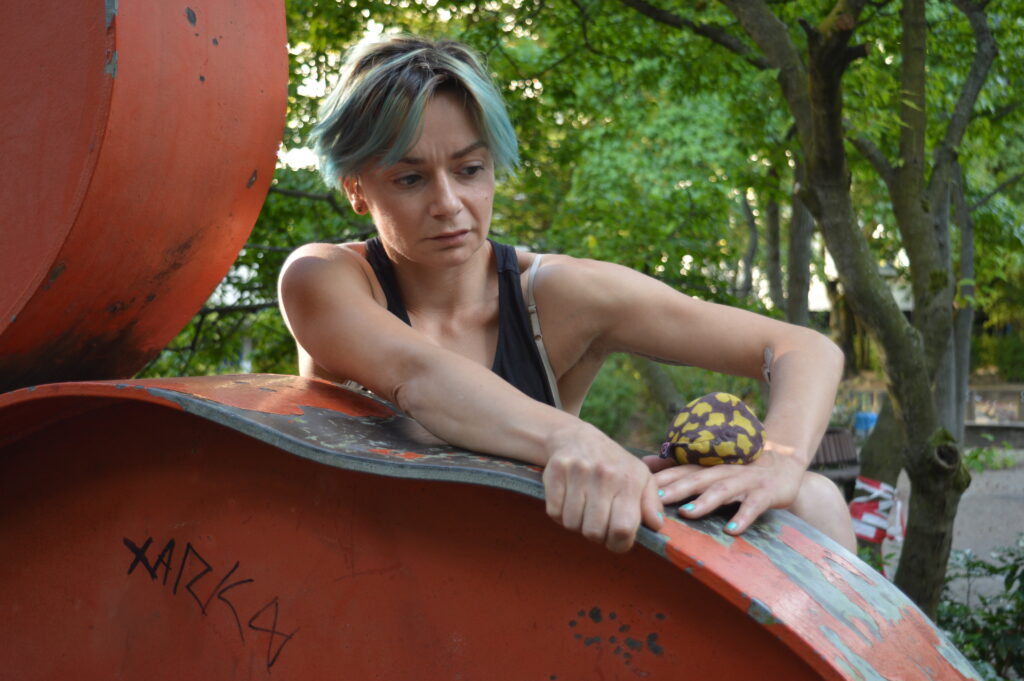
.
FARM
You need a ball to throw and catch for this game.
One person has the ball in their hand and stands in the centre. The others stand around this person.
He throws the ball into the air and calls out the name of another person. This person must try to catch the ball before it falls.
If they succeed, they can throw the ball up again and call out another name.
If it doesn’t work, everyone else has run away in the meantime. If the person gets the ball in their hand, they shout stop and everyone running away must stop.
Now the person with the ball has 3 steps and one throw to hit another person with the ball.
If they hit it, the person thrown gets a new name
If they miss, the person throwing the ball gets a new name
The person who has been given a new name can start the second round and throw the ball up and call out a name….
Now comes the difficult part. All players have to remember each other’s names, because if someone uses the wrong name, that person gets a new name.
Possibilities: Animals, plants, fruit, vegetables, tools, everything there is on the farm.
Translated with DeepL.com (free version)
.
MOTION TENNIS
There are many different possibilities here. Here are two examples.
1
Draw a small square on the floor with chalk, with a line in the middle. Each player stands on one side. Now play tennis with your hand, but only with strokes from bottom to top. Hitting downwards is not allowed and immediately results in a point for the other player. The first player to reach 10 points wins.
2
Each person gets a tennis ball. Now the person tries to volley the ball against the wall with the palm of their hand as many times as possible.
It becomes more difficult with the back of the hand or with the fist.
.
FLOOR TIPPING
You stand on one leg. Any straight floor is suitable as a playing field.
Now choose a spot on the floor that you tap without falling over.
As soon as you stand upright again, choose a new spot to tap.
If you take a pavement with stone slabs, you can try to tap all the stones within your reach.
If you want to make it more difficult, you can stand on a stone and try again from this position.
You can also tap the targets with your foot, or stand in front of an obstacle and choose places on it to tap.
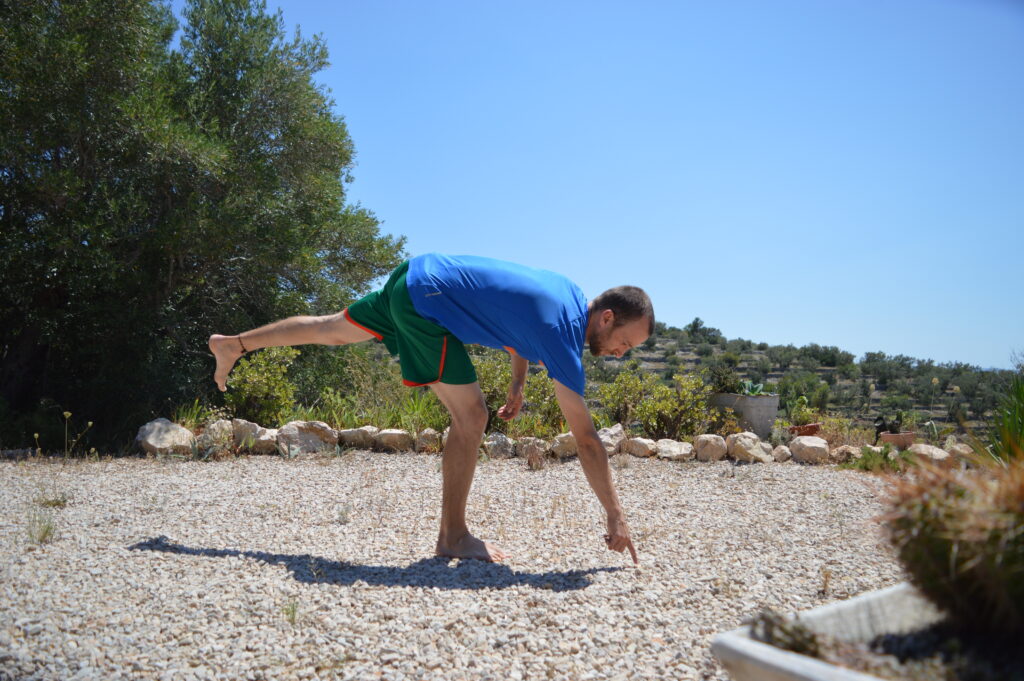
.
CAPTURE THE FLAG
2 teams
Each team has a base into which three balls are placed. A line is drawn in the centre of the playing field.
The base must be large enough so that an opposing player cannot be reached from the outside. Each team should be between 3 and 5 people tall.
Now each team tries to steal the balls from the other team. If you are caught between the centre line and the opponent’s base, you have to go back behind the centre line and can start again. Once you have reached your opponents‘ base, you can try to transport one of the balls to your own base. If you are caught up to the centre line, you must drop the ball where you were caught.
Once you have crossed the centre line, you can take the ball to your base at your leisure.
The game is over when one team has no more balls.
The balls may not be hidden in the base and no more than two players may ‘camp’ at the base.
3 teams
The goal here is the same as for two teams. However, there is no centre line. If you are caught anywhere on the pitch, you have to go to your base, tap it and then restart.
The game usually ends after a certain amount of time, as one team usually doesn’t get all the balls into its base at the same time.
.
THREE STEPS
Two people play together. They are given a ball. A start and a finish are determined.
One person gets the ball, the other (without the ball) is allowed to take three steps on the ground before they have to be on an obstacle again. Then the ball is thrown and the second person is allowed to take three steps to move forwards. Etc.
If the ball falls down or one step too many is taken, the team receives a point. Once the team has reached the finish line, all the points are added up.
On the way back from the finish to the start, each team tries to beat their score.
.
THREE WAYS UP
The aim of this game is to find 3 different paths to an obstacle. There are already predefined paths on the playground. Depending on the level of the participants, you can also look for paths that are not predetermined to get to the top. Getting to the top backwards, even though the path is the same, also counts.
.
OVER, UNDER, THROUGH
Two people play together. They choose a starting point and a destination on the other side of the obstacles. One player can decide whether they have to climb over, under or through the obstacle.
There is a change at each obstacle so that each player can decide what to do.
.
EARTH
Earth is a catching game where the person who catches is blind. For this, it is good if it is a place where the players are often and know it relatively well. All players start on the obstacles. The blind catcher now tries to catch the players. The players are allowed to use the ground, but if the catcher thinks he hears someone on the ground, he can call earth. If someone is on the ground, the catcher changes.
If no one is on the ground, the game continues as before. If the catcher calls earth, he must not open his eyes to look, but must wait for the players to answer, otherwise he will see where everyone is.
.
EXPLAIN THE WAY
Two people play together. One person is blind and the other person explains what is happening along the way.
It is important to move forward slowly, otherwise you will fall or bump into something. In addition, the person who explains must constantly say what is happening, even if it is only straight ahead and there is no obstacle.
They must also explain how the other person can overcome the obstacles.
After that, they swap places.
.
EXPERIMENTING
When experimenting, you have 5-10 minutes to try out movements in a small predetermined spot. What is possible, what can you think of? You experiment in pairs or threes.
If you can do a lot of movements, you will make fast and creative progress and quickly come up with new ideas.
All players should collect ideas on their own and learn ideas from other people and groups.
.
FIRE, WATER, STORM
You give fire, water and storm each a meaning. For example: with water, everyone has to climb on something, with fire, everyone stands against a wall and with storm, everyone lies down on the floor.
Everyone moves to a rhythm. When they stop playing, you call out fire, water or storm. When everyone has assumed the corresponding position, the game continues.
Possibilities: You can also add new words with meaning, such as kangaroo and then everyone has to jump or worm and everyone has to crawl.
.
FLOOR IS LAVA
The floor must not be used here, because the floor is lava and it is hot.
You can specify a route or just a starting point and let the people choose their own route, depending on the level. Each person then climbs and jumps as far as they can without touching the ground.
.
FOLLOW
In Follow, one person is in front and everyone else follows them like geese. It is important that the movements of the first person are not imitated, only the path must be used.
After about a minute, the person in front moves to the very back and the second person continues.
In this way, everyone comes to the front once and rotates fairly through all positions.
.
FOOTWORK
You will need chalk for Footwork. There are rectangular, slightly larger squares, small square squares and a starting square.
These are painted close together. The square squares are for one foot, while the rectangular squares are for two feet at the same time. Now each player chooses squares so that he/she can place four feet.
The player starts in the starting square, places his/her four feet and hops back into the starting square.
Then he/she chooses new squares.
.
FOOT & HANDPRINTS
There are hand and footprints in two different colours all over the pitch.
Blue = right
Red = left
The person playing must tap the hands and feet and may only move on the obstacles.
Hands and feet must be tapped in the same way as they were painted.
Once all the tracks have been tapped, the game is over.
.
GAME OF STICKS
Game of Sticks is the same game as Horse (basketball) or Skate. One player starts by doing a jump, which they must land without any further movement, wobbling or similar. If they succeed, everyone else has to copy the same jump. If they fail, it is the next player’s turn to perform a jump. Any player who cannot copy a jump that has been performed receives a letter from the word STICKS. The letters are collected one by one. When a player has received all the letters of the word STICKS, they are eliminated. The task of performing a jump is taken in turn.
.
RUBBER BAND LANDING
You need a rubber band that is not too small, but also not bigger than the circle your thumb can make with your index finger.
One person sets the challenge. Where is the jump and where does the rubber band go?
Now everyone has one jump to land on the elastic band with both feet if possible.
Points: both feet = 3 p. , one foot = 1 p. no foot = 0 points
The game ends when a player has reached 20 points.
If you want to make it more difficult, you can use the no foot hits as a deduction from the previous points.
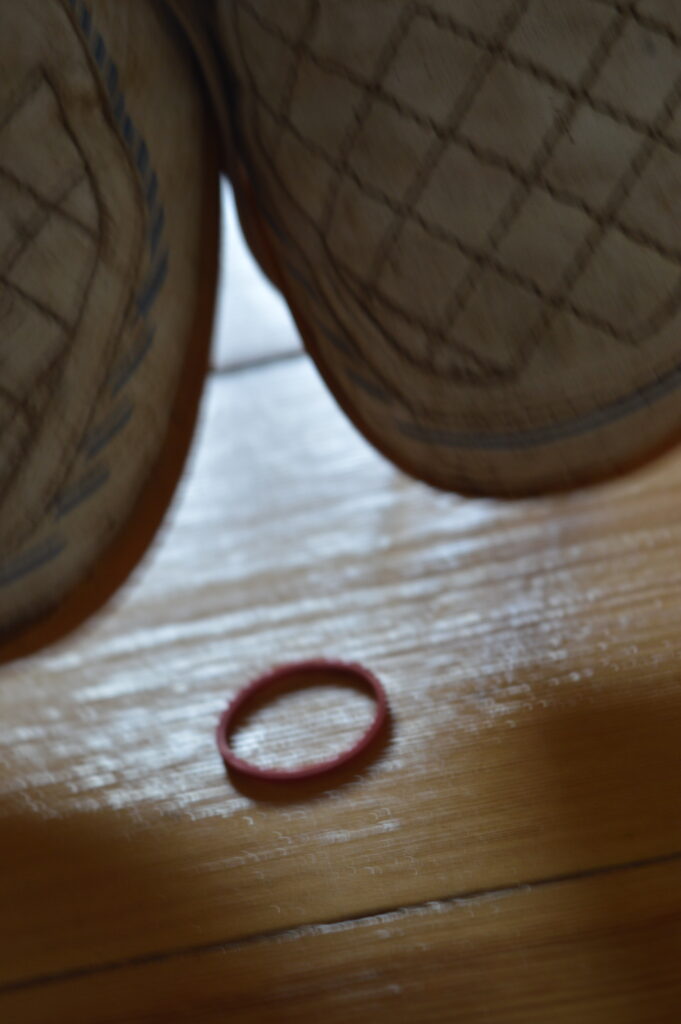
.
HAND IN HAND
Two people hold hands. Now they try to climb over, through and under obstacles together without letting go of their hands.
.
TOUCH HANDS
One person stands on one leg, the other holds out their hand to tap. Left, right, up, down, front and back.
The person standing must not turn their foot and must keep tapping their hand without falling over.
If you want to make it more difficult, you can change hands when tapping, so you may have to tap crosswise.
Be sure to switch feet and then swap roles so that everyone is doing something for their balance.
Translated with DeepL.com (free version)
.
HIT HANDS
Two people are facing each other in the push-up position.
Now each person tries to hit the other person’s hand. Your hands should be in constant motion so that you are not hit but can hit.
When one person has 5 points, the game is over.
.
OBSTACLES/BUILDING BLOCKS
A field is marked out on the floor. Not too big, but not too small either. Large enough that you can make several movements on the floor without leaving the field. The first person makes a few movements and then places an obstacle/building block in the field. Then it is the next person’s turn. Bit by bit, the field fills up with obstacles/building blocks and it becomes increasingly difficult to move smoothly. If someone knocks over any building blocks, the game starts again from the beginning, or the building blocks are removed and the game continues.
.
I CHALLANGE YOU
To do this, it is important that the people have known each other for a while and know what they can expect from the others.
One person thinks about a challenge and goes to another person with it. They say: ‘I’ll challenge you’. Now the person with the challenge has to explain the challenge to the other person, then demonstrate it and then the other person tries to imitate the challenge.
Each person can say at any time: ‘I’m not doing that’.
Important: Give yourselves challenges that are realistic and do not exceed the maximum.
.
ADD ON
Everyone knows the game add on. Let’s turn it into a movement game.
One person starts with a movement (always possible for everyone). The second person repeats this movement and adds a new one. And so on until some movements are connected (6-10).
Now the aim is no longer to add more movements, but to make the movements more fluid. Leave out unnecessary steps, no pauses for thought or similar.
Repeat the series of movements 3-5 times and let the other people tell you where you can become more fluid.
.
STRAIGHT FORWARD
You look for a starting line (e.g. a fence, a stone edge).
Each person decides their own straight path, which must contain at least 3 obstacles.
Now each person tries to get to the other side of the playing field and overcome the corresponding obstacles.
The hands and feet may move out of the straight path, but the body may not.
Once you have reached the other side, you can set a new path with a new start and a new finish.
.
GAME OF BOXES
A start and finish line are drawn on the floor. In between, there are lots of boxes (min. 20) into which both feet should fit easily next to each other. You can play the game on a flat floor or incorporate obstacles.
Players: 3 or more
One person starts in the starting box and jumps through the boxes to the finish. Not all boxes have to be used.
Important: The chalk edges of the boxes must not be touched and hands and feet must not touch outside the boxes.
If the person has reached the finish without making a mistake, he/she may label a box with his/her name. This field may only be used by this person.
Then it is the next person’s turn. Over time, the boxes fill up with names and each person tries to mark a path to the finish for themselves.
If a person does not get through or makes a mistake (touching the line or touching the ground with their hands outside the squares), this person may not mark a square.
The game ends when some people always get through.
The following rule applies to obstacles. These may be touched, but you may not stand on them, only sit, kneel or place your hands on them.
If there is a size difference in the group, the smallest person always starts.
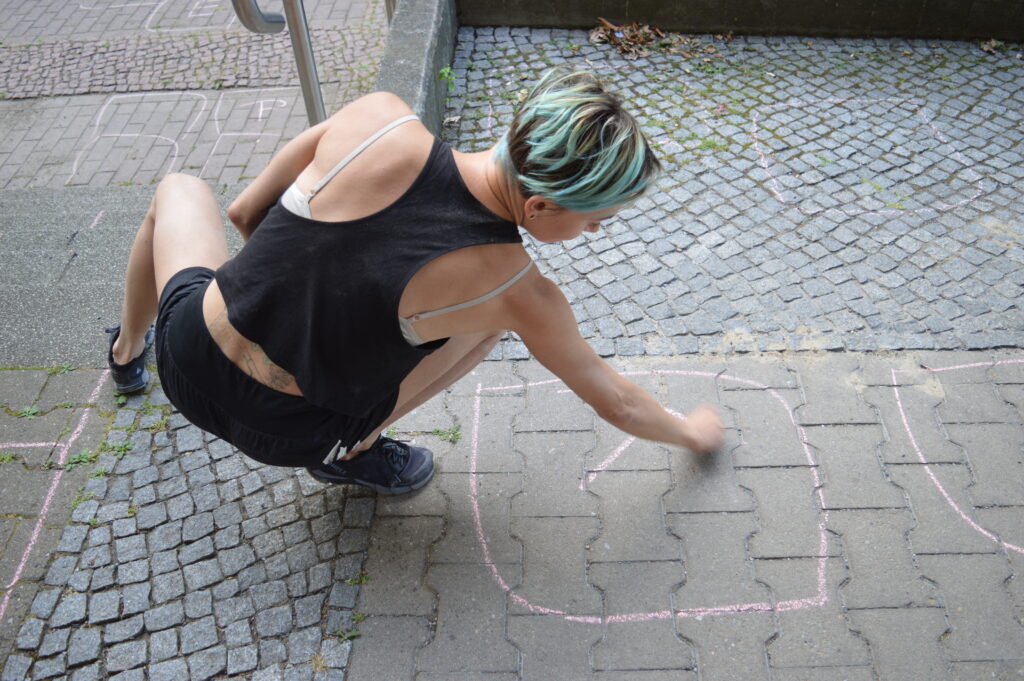
.
JUMP BOXES
Squares are drawn on the floor with chalk. These can be of different sizes, distances and shapes. There is a starting square and a finishing square. Now all players try to get from the start to the finish without touching the chalk lines or the floor outside the squares.
.
CONCERT MASTER
All players stand in a circle. One volunteer steps out of the circle and covers their eyes. Now a concertmaster is chosen without words.
The volunteer now goes to the centre of the circle.
The concertmaster begins to demonstrate movements that the entire concert must imitate as quickly as possible (e.g. jumping, jumping jacks, shaking arms, hip circles, etc.).
The person in the centre has to find out who the concertmaster is.
Once the concertmaster has been found, the roles change for a new round.
.
KREIDE KREISLAUF
Draw a circle on the floor with chalk.
Circles = jumping with both legs
Line = balancing
Hands = use hands
Feet = use feet
The circle can be small and does not have to contain any obstacles.
However, it is more exciting with obstacles.
If you want to make it more difficult, have the circuit run in the other direction or do all the movements backwards.
.
LAND CORRECTLY
There are many different ways to do this.
But first, you should know what is correct and what is not.
The correct landing in parkour is on the balls of your feet, with your legs bent (as if you were sitting down). Your feet can be close together or shoulder-width apart, depending on your preference and the jump. It is similar with walls and bars, except that you use the midfoot as a ‘brake’ and thus roll first with the midfoot and then with the forefoot.
EXAMPLES:
Draw pairs of feet on the floor with chalk. These are in different directions and distances. Now the participants should jump into the pairs of feet and remain stable without wobbling or moving.
OR
Find a staircase. Now try to land correctly 10 times on the different steps. You decide for yourself whether you are satisfied with the landing or not. Every satisfactory landing is counted.
OR
Find a wall and draw different squares on the floor with chalk. Now draw a line from which you will jump. Use the tic-tac-toe as your jump. Jump in front of the line, tic-tac-toe, and then try to land in a square.
.
LINE BUILDING
Find a nice spot and try to string together 3–8 movements smoothly. You can think about the movements during the process or beforehand.
I have also created cards that you can use for this. You can find them under Materials.
Now try to make your line as fluid as possible. Fluid does not mean fast, but without pauses and unnecessary steps and turns.
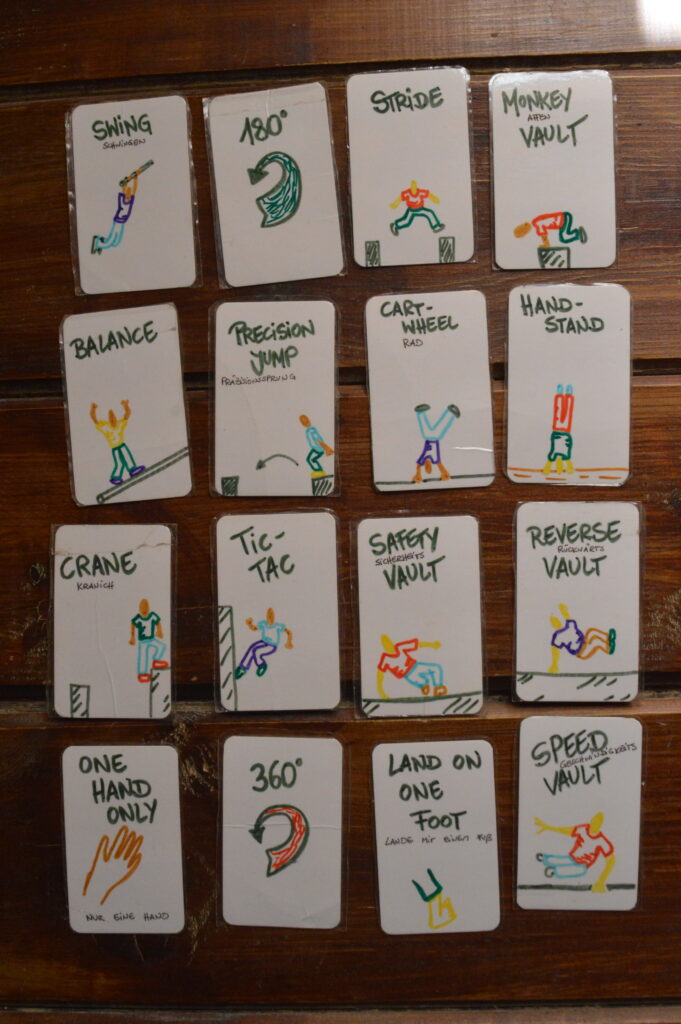
.
HUMAN, ANIMAL, MONSTER
A game for younger children.
One person is the game leader.
This person can announce how the other people have to move.
Human: The normal way a human moves.
Animal: Each person chooses an animal and moves like the animal, on all fours, swinging their arms, jumping or crawling.
Monster: Each person makes noises like a monster and moves in a creepy way.
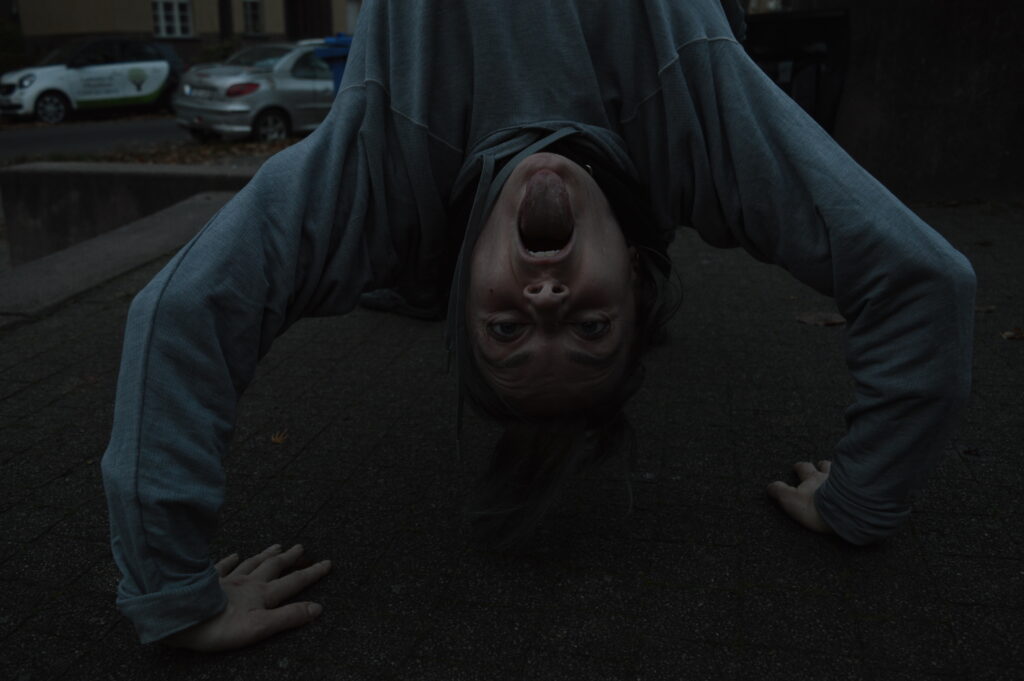
.
GUIDE
One person is blind folded and must be guided by the other person.
The guide must always explain what is happening along the way so that no one falls or bumps into anything.
Once the path has been completed, the roles are swapped.
.
NORMAL, SLOW MOTION, STAND STILL
One person is the game leader. This person tells the others how to move.
Normal = at normal speed
Slow motion = slow, as in slow motion
Standstill = no one is allowed to move
Very interesting with obstacles, as standstill and slow motion are more difficult to realise.
.
ONLY ONCE
A route from A to B is specified. No obstacles at the start.
Now each person may only perform all movements once to get to the other side.
The same movement only on the other side (e.g. hopping on one leg left and then right) is not allowed.
Get creative and see what the others do.
If you want to make it more difficult, you can use a route with obstacles or extend the path.
.
FRUIT SALAD
All players sit in a circle and are given fruit names. Each fruit must appear several times (2-4 times).
Now you say one of the types of fruit and the corresponding people must quickly swap places. You can also say several types of fruit, which then have to change places.
If you say fruit salad, everyone has to swap places.
If you want to make it more difficult, all the players are on an obstacle and have to swap places without touching the ground.
.
PRECISION TREE
You draw a tree on the floor with chalk. The trunk is the jump and in the crown you draw squares of different sizes and shapes.
Now you try to land in the squares without touching the lines or the ground around the square with
your feet or hands. You have 3 attempts to land.
If you manage it the first time, you write a 3 in the box for 3 points. If you manage it on the second attempt, you write a 2 in the box for 2 points. On the third attempt, write a 1 for 1 point and if you don’t make it, write a 0 for 0 points.
When you have made all the squares, add up all your points and then start a second round with the same squares and a different colour of chalk for the numbers.
.
RIGHT, LEFT, FORWARD, BACKWARD
This game is played in pairs. One player says where to go and the other has to move accordingly.
FORWARD and BACKWARD are clear. RIGHT and LEFT mean that you have to move to the right or left without turning your body, otherwise you will be back to forward or backward. The game works best in a narrow space, a playground with lots of equipment or a parkour facility.
.
ROCK, PAPER, SCISSORS
The playing field is a long row of boxes.
Two teams play against each other.
Each team starts on one side of the boxes.
With both legs, they have to jump from one box to the next as quickly as possible.
Where they meet, they do a round of paper, rock, scissors.
Whoever wins gets to keep jumping. If you lose, you have to leave and let a team player jump again from the start.
The team that arrives on the other side is the winner.
.
SHAOLIN COMBO
You will need chalk or stencils for the game.
Blue = right
Red = left
You always draw a three-way combo of hands and feet next to each other.
A total of 10 three-way combos in a row.
The person playing has to hop in all three hands/feet at the same time until they have completed the whole course.
If someone makes a mistake, they are not allowed to continue playing and have to start again.
Aim: To reach the end of the course without making a mistake and taking as little time as possible.
To do this, you should run the course a few times.
If you have templates, you can quickly rearrange your hands and feet. If you have chalk, you have to draw a new playing field.
If you don’t want to draw a new playing field, you can also run the course backwards.
.
SILENT NINJA
Silent Ninja is played in pairs, with as much distance as possible between the players. One person is the ninja and has to sneak up on the other person. The other person stands with their back to the ninja. If the other person hears the ninja, they have to start again. After a few attempts, the roles are swapped.
Important: DO NOT cheat when listening.
If you want to make it more difficult, the playing field has obstacles in the ninja’s way.
.
SIMON SAYS
One person is Simon, everyone else has to do what Simon says.
BUT:
Simon can say, ‘JUMP,’ and then you don’t have to do what Simon says.
ONLY
when Simon says, ‘SIMON SAYS, JUMP,’ do you have to follow his instructions.
Example:
‘SIMON SAYS, RUN’ = Everyone has to run on the spot
‘JUMP’ = Everyone must continue running on the spot because SIMON SAYS was missing.
‘SIMON SAYS JUMP’ = Everyone must jump
The round continues until Simon manages to get someone to make a mistake. That person then becomes Simon in the new round.
BUT
Simon is not allowed to say ‘SIMON SAYS RUN’ and then ‘RUN’.
.
AS FAR AS YOU CAN
Here, a START is selected on one side of the playing field. The goal is to get to the other side without touching the ground.
The rule is: NO risk. If you get stuck, stay where you are or start again from the beginning.
If the playing field has too many large gaps, you can play ‘AS FEW STEPS AS POSSIBLE’ (instructions in the next game in the list).
.
AS FEW STEPS AS POSSIBLE
A start and a finish are specified.
Everyone should get from the start to the finish and take as few steps on the ground as possible.
Each person can decide for themselves where they want to go to reach the finish line.
All steps on the floor are counted independently.
There is a task for each step, e.g. push-ups, hanging from a pole for 10 seconds, etc.
.
MIRRORING
Two people stand opposite each other.
One person performs movements in slow motion, which the other person has to mirror.
The roles are then swapped.
.
STELLA, STELLA
IN ARBEIT…
.
STEP COMBO
In Step Kombo, you draw a starting field with chalk.
Then draw square and rectangular squares on the floor as you see fit.
The square fields may only be used with one foot. The rectangular squares must be used with both feet at the same time. Now each player can try to get through the squares to the other side.
.
COLLECT STARS
One person draws stars with chalk all over the obstacles.
It doesn’t matter how many there are.
The stars should be painted from easy to difficult to reach so that people who are good at climbing still have challenges.
You can let people search after a certain time or until you realise that the majority of people are no longer searching.
You can do the same with other things (fish, hands, etc.).
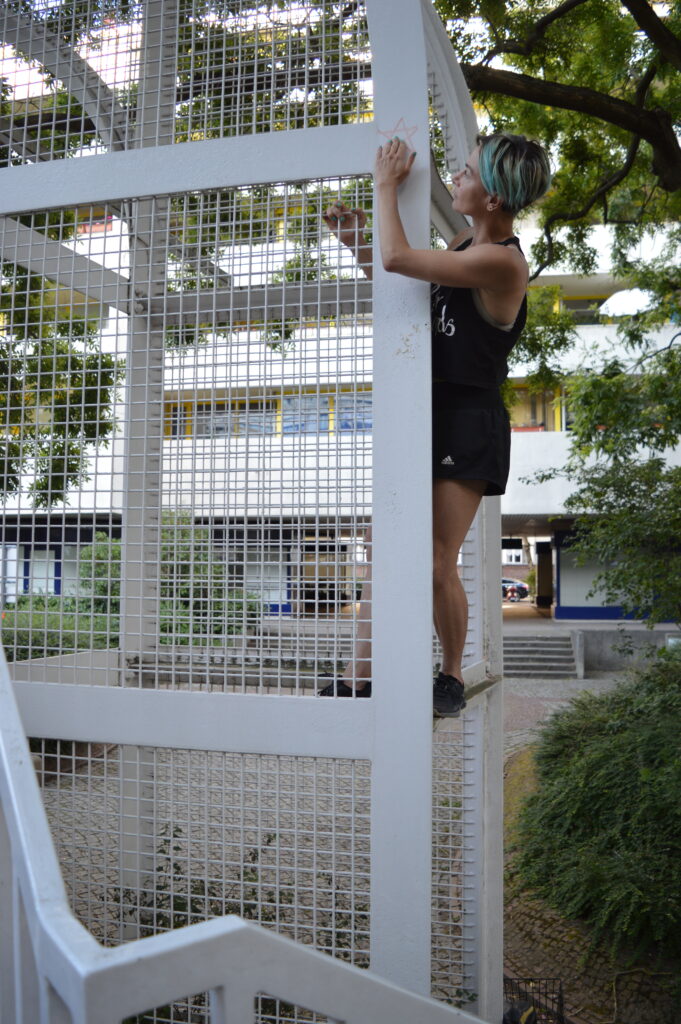
.
STRIDE PRACTICE
What is a stride? A stride is a one-legged jump that is performed by one leg and usually landed with the other leg. A series of strides is usually strung together if the obstacles make this possible.
Use chalk to mark a pair of ‘bars’ on the floor where your feet should land.
The distance between them varies depending on your height.
If you draw a lot of beams, you can simply make them wider and wider.
Aim of the exercise: Each foot only touches one beam at a time. This trains the assessment of speed, jumping power and distance, as well as the accuracy to land properly on each bar.
If you want it to be more difficult, you can perform the same exercise with obstacles. However, this exercise is more suitable for more advanced people with good balance and coordination.
.
STICK CATCH
Two people play together and are given a long stick.
One person is allowed to put the stick down and carefully let it fall over.
The other person must try to catch the stick as low as possible, i.e. just before it touches the ground.
After a few attempts, they swap.
.
SUMO
Two people squat close to each other.
Each person wants to try to push the other person out of the squatting position.
The following rules apply:
Only the shoulders and arms may be pushed or pulled.
When pulling, no one may hold on for long (only short impulses).
If one person falls over, the other gets a point. Whoever has three points first wins.
.
SYNCHRONIZING
Two people play together. They put together a short line (3 – 4 movements).
Now they try to run through this line together in synchronisation.
Important: Both people should be able to do all the movements and one person sets the tempo and the other tries to follow.
.
TEPPICHFLIESEN WANDERN
ONE PERSON has two carpet tiles and must get from a starting point to a finishing point without touching the floor. Each step must be on a tile. The tiles must therefore be constantly moved in order to progress.
SEVERAL PEOPLE have 3-4 carpet tiles. Now you have to share the space and always have an empty tile so that you can move it. How many tiles you use depends on the size of the tiles, the size of the group and the height of the players.
.
TIC TAC TOE
Just like on a sheet of paper, a field is drawn with chalk.
Down from an obstacle or over one.
The square that a player wants to mark must be jumped over.
The following applies
- Do not touch a line
- Do not be outside the field with your hands or feet
Once you have jumped into the square, you can mark it. And so on until all the squares are full or one person has won.
.
TWISTER 3D
IN ARBEIT…
.
SEARCH CLOTHES PEGS
As with the ball hunt, one person hides clothes pegs.
All clothes pegs must be hidden in a visible place and can be attached anywhere.
On the obstacles on the playing field, as well as trees and bushes.
Once all the pegs have been hidden, you can search for them.
Tip: Remember how many staples there were.
Tip: Difficult hiding places are often at foot level, as everyone is looking upwards.
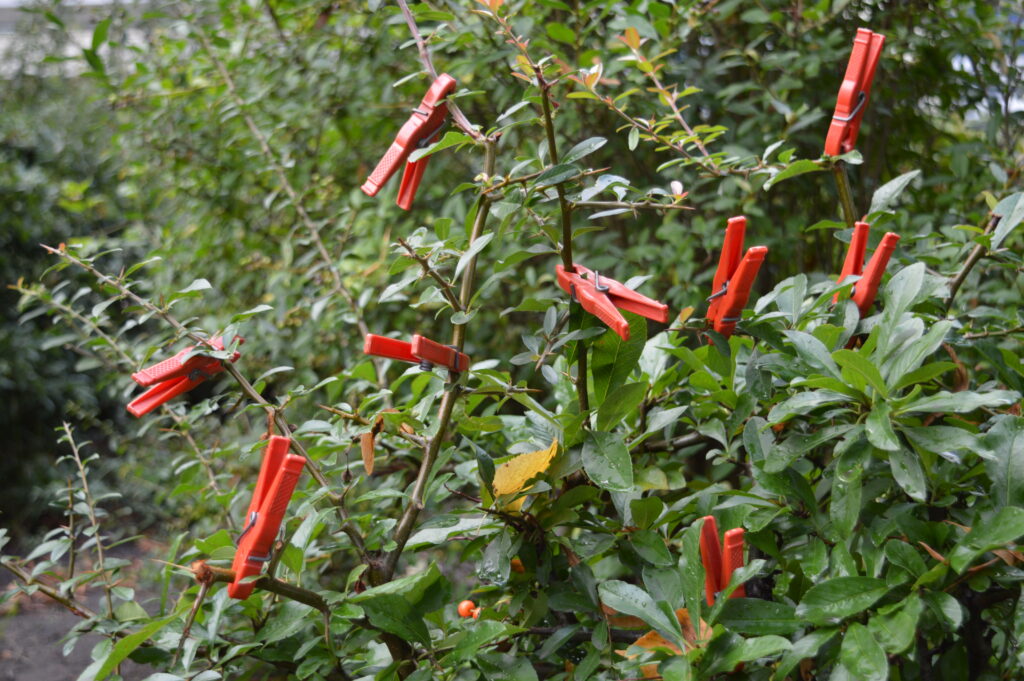
.
WHICH FIELD
IN ARBEIT…
.
RACE AGAINST YOURSELF
In the race against yourself, you have two timed races. In the first race, you try to be as fast as you can. In the second race, you try to beat your own time.
The course is set in advance and is the same for both races.
.
HOW MANY STARTS
In this game, you take up a position (sitting on the wall, hanging from a bar or standing on a bench).
Now try to make as many movements as possible from this position. Count how many different movements you can do. Then move to another position and try this one.
.
DICE JUMPS
Use chalk to draw a start field (without a number) and a finish field (dice field with the number 4) on the floor. In between, draw lots of squares with the dice numbers in no particular order. Two players play against each other. Each player gets a dice and the game starts on LOS.
Both players can roll the dice when and how fast they want. Each number must be jumped. If the number to the front is no longer available or is blocked by the other player, you have to jump to the back. The first player to land in the target field number 4 is the winner.
.
NUMBER SEARCH
Numbers are written on the obstacles with chalk. All players must tap the numbers in the correct order.
Once they have finished, you can send them off for a second round and have them tap with their foot, head or another part of their body.
.
TAKE ZONES
IN ARBEIT…
.
GLUED TOGETHER
Two people play together.
One part of the body is ‘stuck together’, i.e. it must always touch (e.g. hand, back, shoulder).
Now the pair must climb over one or more obstacles without being detached from each other. If they manage to do so, another body part is stuck together or you give them a more difficult obstacle.
.